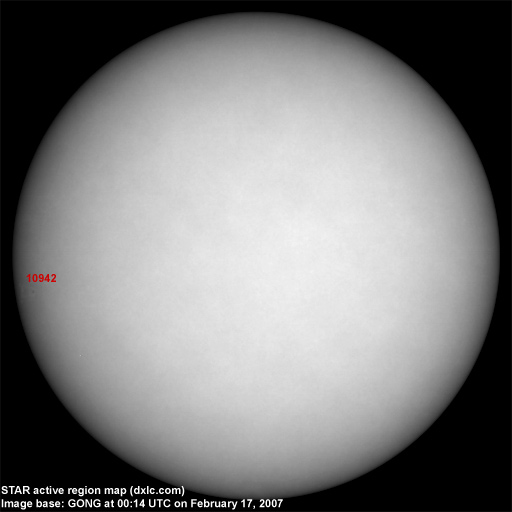

Last major update issued on February 17, 2007 at 05:50 UTC.
[Solar and
geomagnetic data - last month (updated daily)]
[Solar wind and
electron fluence charts (updated daily)
[Solar cycles 21-23
(last update January 11, 2007)]
[Solar cycles 1-20]
[Graphical comparison
of cycles 21, 22 and 23 (last update January 11, 2007)]
[Graphical
comparison of cycles 2, 10, 13, 17, 20 and 23 (last update January 11, 2007)]
[Historical solar and
geomagnetic data charts 1954-2005 (last update March 3, 2006)]
[Archived reports
(last update February 6, 2007)]
The geomagnetic field was quiet to unsettled on February 16. Solar wind speed ranged between 487 and 624 km/s (average speed was 554 km/s, decreasing 131 km/s from the previous day).
Solar flux measured at 20h UTC on 2.8 GHz was 74.7. The planetary A index was 6 (STAR Ap - based on the mean of three hour interval ap indices: 5.9). Three hour interval K indices: 12211123 (planetary), 12212123 (Boulder).
The background x-ray flux is below the class A1 level.
At midnight there was 1 spotted region on the visible solar disk. The solar flare activity level was low. A single C class event was recorded during the day, a C1.7 event at 01:56 UTC.
New region 10942 emerged near the southeast limb early in the day. Slow decay was observed after noon.
February 14-16: No obvious partly or fully Earth directed CMEs were detected in LASCO imagery.
Coronal hole
history (since late October 2002)
Compare today's report to the situation one solar rotation ago:
28
days ago
27
days ago
26
days ago
No obvious coronal holes are currently in or approaching Earth facing positions.

Processed SOHO/EIT 195 image at 21:37 UTC on February 13. The darkest areas on the solar disk are likely coronal holes.
The geomagnetic field is expected to be mostly quiet on February 17-20.
| Coronal holes (1) | Coronal mass ejections (2) | M and X class flares (3) |
1) Effects from a coronal hole could reach Earth
within the next 5 days. When the high speed stream has arrived the
color changes to green.
2) Effects from a CME are likely to be observed at Earth within 96
hours.
3) There is a possibility of either M or X class flares within the next
48 hours.
Green: 0-20% probability, Yellow: 20-60% probability, Red: 60-100% probability.
Daily monitoring will not resume until a local noise problem (related to construction work on a neighboring property) has been fixed. Occasional monitoring reports will be submitted when propagation is good.
February 10, 2007: Several stations from the Canadian Atlantic provinces had strong signals while stations further south and west were weaker than expected.

Compare to the previous day's image.
Data for all numbered solar regions according to the Solar Region Summary provided by NOAA/SEC. Comments are my own, as is the STAR spot count (spots observed at or inside a few hours before midnight) and data for regions not numbered by SEC or where SEC has observed no spots. SEC active region numbers in the table below and in the active region map above are the historic SEC/USAF numbers.
| Active region | Date numbered | SEC spot count |
STAR spot count |
Location at midnight | Area | Classification | Comment |
|---|---|---|---|---|---|---|---|
| 10942 | 2007.02.16 | 2 | 1 | S13E69 | 0060 | CAO | classification was HAX at midnight, area 0030 |
| Total spot count: | 2 | 1 | |||||
| SSN: | 12 | 11 | |||||
| Month | Average solar flux at Earth |
International sunspot number | Smoothed sunspot number |
|---|---|---|---|
| 2000.04 | 184.2 | 125.5 | 120.8 cycle 23 sunspot max. |
| 2000.07 | 202.3 | 170.1 | 119.8 |
| 2001.12 | 235.1 | 132.2 | 114.6 (-0.9) |
| 2005.12 | 90.7 | 41.1 | 23.0 (-1.9) |
| 2006.01 | 83.4 | 15.3 | 20.8 (-2.2) |
| 2006.02 | 76.5 | 4.9 | 18.6 (-2.2) |
| 2006.03 | 75.4 | 10.6 | 17.3 (-1.3) |
| 2006.04 | 89.0 | 30.2 | 17.1 (-0.2) |
| 2006.05 | 80.9 | 22.2 | 17.3 (+0.2) |
| 2006.06 | 76.5 | 13.9 | 16.3 (-1.0) |
| 2006.07 | 75.7 | 12.2 | 15.3 (-1.0) |
| 2006.08 | 79.0 | 12.9 | (15.6 predicted, +0.3) |
| 2006.09 | 77.8 | 14.5 | (15.7 predicted, +0.1) |
| 2006.10 | 74.3 | 10.4 | (14.5 predicted, -1.2) |
| 2006.11 | 86.3 | 21.5 | (12.8 predicted, -1.7) |
| 2006.12 | 84.5 | 13.6 | (12.1 predicted, -0.7) |
| 2007.01 | 83.3 | 16.9 | (12.0 predicted, -0.1) |
| 2007.02 | 79.4 (1) | 9.2 (2) | (12.1 predicted, +0.1) |
1) Running average based on the
daily 20:00 UTC observed solar flux
value at 2800 MHz.
2) Unofficial, accumulated value based on the Boulder (NOAA/SEC)
sunspot number. The official international sunspot number is typically
30-50% lower.
This report has been prepared by Jan Alvestad. It is based partly on my own observations and analysis, and partly on data from some of these solar data sources. All time references are to the UTC day. Comments and suggestions are always welcome.
| [DX-Listeners' Club] |